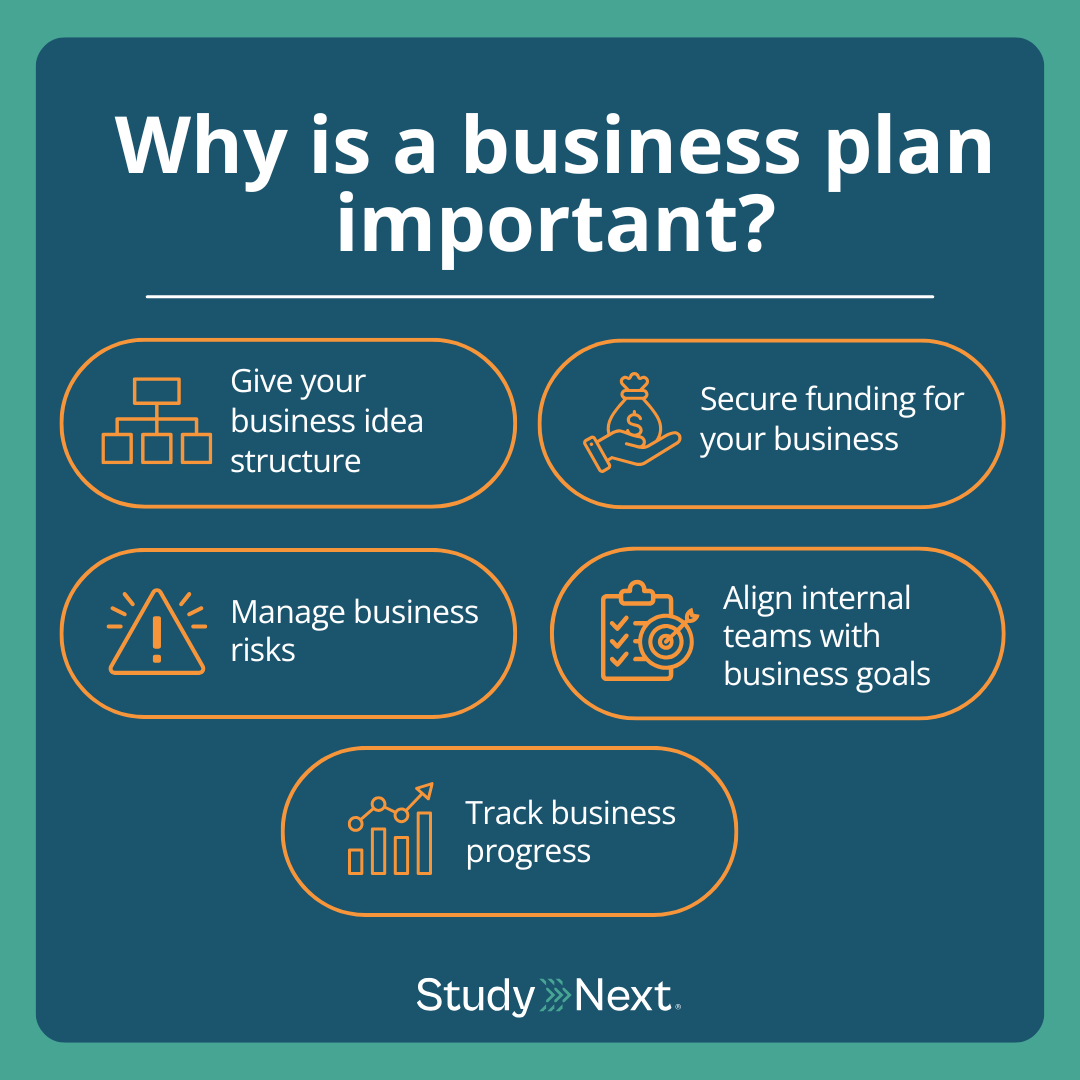
Are you unsure how to draft a business plan? With so many aspects to cover, including marketing strategies, financial planning and legal requirements, you can create a roadmap to help your business thrive.
This article explores what a business plan involves, why it’s important and how to create one. You’ll also discover useful resources to support your planning process and practical tips to help you succeed.
How to write a business plan: step by step
Writing a business plan involves presenting your business profile, objectives and strategies in a clear and organised format. While the structure and content may vary depending on the nature of the business, most business plans typically include key components like an executive summary, market and competitor analysis, marketing strategies and financial planning.
The following is a step-by-step guide to help you write the key sections typically included in a business plan:
1. Executive summary
Every business plan should start with an executive summary, which contains an overview of your entire business plan. Although it appears at the beginning, this section is usually written after all other parts of the plan have been finalised.
The purpose of this section is to provide a concise summary that communicates what your business is about and why it’s worth investing in or supporting. It should highlight the most important aspects of your business, which may include:
- Short-term and long-term business goals
- Unique selling points
- Business ownership and legal structure
- Target market and customers
- Products and services offered
- Business operating model
- Amount of funding needed
- Business expansion plans
This section is often the most important part of your business plan as it may be the first, and sometimes only, section that potential investors and key stakeholders read. By writing a compelling executive summary that delivers the value of your business, you can make a strong first impression to build confidence in your business potential.
2. Business profile
The business profile section of a business plan provides readers with a clear understanding of your business’s background and structure. Whether you operate as a sole trader, partnership or company, this section covers the foundational details of your business. It typically includes your business history, vision and core objectives, along with the timeline for achieving them.
You can describe your niche market and the specific problems you want to address with your products or services. This section can also introduce who owns the business and key leaders, including their roles, qualifications and experience.
The business profile should engage your readers and help them grasp what your business stands for and why it’s positioned for success.
3. Products and services
The products and services section includes detailed information about what your business offers customers. It explains how they work, what value they bring and how they can meet customer needs. You should highlight the unique selling proposition (USP) of your offerings to demonstrate what makes your products or services stand out from the competition.
In this section, you should describe how your products are produced or how your services will be delivered and if there are suppliers involved. It should also cover your pricing strategy and the rationale behind it. If you have intellectual property such as registered patents, trademarks or copyrights, be sure to include them as they can enhance your business’s credibility. You can also mention if you’re planning to expand your services or introduce new products in the future.
This section is essential for showing potential investors and stakeholders the feasibility and commercial potential of your business, whether you're launching a new venture or looking to grow an existing one.
4. Market and competitor analysis
This section outlines your understanding of the market your business operates in and how it fares against other competitors. It demonstrates your grasp of industry trends, customer needs and how your business can thrive within this landscape.
You can discuss your target market, describing your ideal customers and their preferences. This may include data on customer demographics, purchasing patterns and the demand for your products or services. You can also demonstrate your competitive advantage by analysing your competitors and comparing their offerings with yours. A Strengths, Weaknesses, Opportunities and Threats (SWOT) analysis is often used here to identify what areas you are doing well in and where there’s room for improvement.
In this section, you can also examine social, environmental or technological changes that may affect consumer behaviour. Highlighting these trends shows stakeholders you’re aware of potential challenges and opportunities your business may face and that you’re well-equipped to adapt and remain competitive. Ultimately, this section proves that you have a solid understanding of the competitive environment and a well-defined strategy to succeed within it.
5. Marketing strategy
In the marketing strategy section of a business plan, you should cover how your business will attract, engage and retain customers. No matter how great your business offerings are, it wouldn’t matter if potential customers aren’t aware of them.
This section typically provides information about your target customers. This involves analysing key factors such as age, location, income, interests and behaviours to create a customer profile. Understanding who your audience is allows you to tailor your messaging and choose the most effective marketing channels, whether it’s social media, email campaigns, traditional advertising or in-person events.
You should also outline your marketing objectives and the budget allocated to achieve them. These goals may include increasing brand awareness, generating leads or acquiring new customers. You can also highlight metrics such as customer acquisition costs, conversion rates or return on investment (ROI).
By clearly describing how you plan to reach your audience and grow your customer base, this section demonstrates your business’s potential to build visibility and make profit sustainably.
If you want to enhance your marketing expertise, consider pursuing a postgraduate marketing course, such as the Graduate Diploma in Marketing at the University of Technology Sydney (UTS). You’ll gain comprehensive knowledge of core marketing principles and management, with topics like marketing communications, brand management, social impact and customer behaviour. The course also teaches you how to identify and address marketing challenges with strategies that are applicable both within the Australian context and on a global scale.


Choose this program to gain contemporary insights into market analysis and strategic development, informed by our faculty's research expertise. Its distinctiveness lies in the focus on adapting to the evolving marketing environment, covering topics such as marketing communications, brand management, social impact, customer behaviour, strategy, data analytics, and ethical considerations.
Students acquire the ability to identify and resolve marketing management challenges, and develop strategies applicable both in Australia and globally. The learning experience is flexible, offering a choice of subjects, study pace, and session timing to suit their needs.
6. Financial planning
The financial planning section outlines your business’s financial health, funding needs and projections. It demonstrates how your business generates revenue, manages costs and plans to remain financially stable over time. This section gives potential investors or lenders the financial transparency they need to assess your business’s profitability and sustainability. It typically includes key financial documents and data such as:
- Balance sheet
- Net profit margin
- Cash flow statement
- Profit and loss statement
- Break-even analysis
- Financial forecasts
If you’re writing a business plan for a small business startup that hasn't been launched, you should include projected startup costs. When seeking external funding, clearly state how much funding you need and what it will be used for. If you need support in drafting this section, it may be helpful to seek professional guidance from an accountant.
This section is crucial for building trust with stakeholders. It demonstrates that you have a solid grasp of your financial responsibilities and a realistic plan to achieve business profitability.
Studying a postgraduate finance course can help boost your financial skills, which is essential for every business owner. The Graduate Certificate of Finance course at Macquarie University is suited for those seeking a comprehensive understanding of finance to advance in their existing field. You’ll explore case studies in applied finance and take on units like Finance Principles, Quantitative and Economic Analysis as well as Financial Statement Analysis and Modelling.


Finance – the study of activities associated with banking, capital markets, investments, money, credit and debt – is a continuously evolving and exciting field. Those with corporate finance and investment management skills are in demand across the globe.
Offering considerable flexibility, the Graduate Certificate of Finance is ideal for those wishing to transition to the finance industry or those seeking a comprehensive understanding of finance to progress in their existing field. With four commencing dates each year and four units of study, you’ll progress through structured learning activities facilitated by teachers with extensive industry experience. If your prior studies aren’t in the fields of business or finance, this course is a pathway to the Graduate Diploma of Applied Finance and the Master of Applied Finance.
7. Legal requirements
The legal section of your business plan covers the legal obligations your business must meet to operate within the law. This includes specifying the necessary licenses, insurance, permits and leases relevant to your industry and business location. Since this section involves significant legal considerations, it’s strongly recommended that you get assistance from a lawyer.
If your business employs staff, this section should also address your responsibilities as an employer. This may cover topics like fair work practices, occupational health and safety standards and anti-discrimination laws. These details show that you are committed to creating a compliant and responsible work environment.
Outlining these legal considerations demonstrates that you’ve taken the necessary steps to minimise legal risks, helping to build credibility with investors, partners or lenders. It also keeps you prepared for any regulatory changes, reducing the likelihood of costly penalties later on.
8. Operating plan
The operating plan section outlines how your business will function on a day-to-day basis to deliver its products or services. It explains the internal processes, resources and logistics involved to support daily operations. This may include where your business will operate from, how you’ll manage supply chains and maintain equipment and inventory.
In this section, you can also cover your staffing needs, team structure and how responsibilities are assigned. This gives readers a clear understanding of how your workforce contributes to operations. A well-developed operating plan also considers potential risks or disruptions, such as economic downturns or supply chain delays, by including contingency plans to help the business stay resilient in unexpected situations.
By providing a detailed view of how your business will operate, this section shows that your business is well-equipped to manage resources effectively to position itself for long-term growth.
If you’re looking to hone your knowledge and skills in operations management, you can explore relevant postgraduate degrees, like the Master of Business (Operations Management) course at Western Sydney University. The program equips you with the skills to plan, implement, upgrade and manage business operations to improve customer value and overall organisational effectiveness. You’ll develop an integrated and holistic approach to operations management while exploring sustainable practices in operations management, project management and logistics and supply chain management.


Develop an integrated and holistic approach to operations management, whilst gaining exposure to the latest research in sustainable practices in operations management, logistics, supply chain management and project management.
The Master of Business (Operations Management) is an innovative program that equips you with the necessary skills to plan, implement, upgrade and manage business operations to enhance customer value and organisational effectiveness. You'll learn about the relationship between business processes, cost-effective practices, how to manage the effects of current and future trends in supply chain management and importantly, use a systems approach to solve business problems with an eye to the social and environmental impact of your work.
The program is designed for graduates who wish to prepare for senior operations management roles in manufacturing or service organisations, in both the private and public sectors. You will learn operations management, supply chain management, logistics and project management. Develop and enhance your perspectives and the skills necessary for an integrated approach to planning, implementing, upgrading and managing business operations that enhance customer value and organisational effectiveness.
9. Action plan
The action plan section contains the specific steps needed to achieve business goals. It breaks down broader strategic objectives into clear manageable tasks, assigning responsibilities and setting deadlines to ensure accountability. An effective action plan can help keep your teams focused, track progress and make it easier to adjust business strategy when necessary. You’ll be able to assess which actions have been completed, which are still in progress and which may need to be revised.
This section is useful for aligning internal teams, helping everyone understand what needs to be done. It can also give stakeholders confidence that your business has a structured approach for accomplishing goals.
What is a business plan?
A business plan is a comprehensive document that covers key aspects of your business, such as visions, financial situation, operational plans and target markets. This document is essential for many businesses, whether you’re just starting out or running an established company.
The content of your business plan usually depends on the type of business you operate and which stage you’re in. Typically prepared for various audiences, including investors, lenders, partners and internal management, a business plan helps them understand your company’s goals and strategies to achieve them.
Why is a business plan important?
A business plan is essential for many reasons, including giving structure for new business ideas, attracting potential investors and lenders to fund your business and providing you with more control to manage possible risks. The document also keeps internal stakeholders informed and aligned with business goals and helps you track company performance. Learn more below:

Give your business idea structure
If you’re launching a business, writing a business plan gives structure and direction to your idea. You can define your goals clearly, develop strategies and identify potential challenges. You’ll also gain a better understanding of your target market and the demand for your products or services. It acts as a roadmap of what you want to achieve and allows you to determine the feasibility of your business idea.
Secure funding for your business
If you’re looking to get financial support for your business, a well-crafted business plan can help you convince investors and financial institutions to fund you. By clearly outlining your goals to run a profitable business and the strategies to accomplish them, you can provide these potential supporters the confidence they need to believe in your vision.
Manage business risks
Developing a business plan helps you identify risks your business may face, giving you more control in managing them. By analysing market conditions and competitors, you can better understand your business’s strengths and weaknesses, allowing you to identify gaps and make improvements. A business plan also typically includes legal requirements to ensure your business is compliant with relevant regulations. This can help you manage legal risks so you can avoid costly compliance-related penalties and safeguard your business in the long run.
Align internal teams with business goals
A business plan contains a company’s visions and goals, helping internal teams to understand what the business wants to achieve and how their roles can contribute to those goals. These objectives are typically broken down to actionable steps with clear deadlines and assigned responsibilities. This keeps teams focused and accountable to reach their targets, which can contribute to overall business performance.
Track business progress
You can use a business plan to monitor the growth of your business over time. The document provides measurable goals and timelines, such as revenue targets and product launches, that can serve as performance indicators. This helps you identify what's working and what needs improvement, allowing you to adjust business strategies accordingly.
Where to find resources for your business plan
You can find plenty of organisations that offer valuable resources, support and tools that can help you learn how to develop a business plan effectively. The Australian Government’s business portal is a great starting point, providing comprehensive guidance on how to start and manage your business. It offers a wide range of templates, including business plans, marketing plans and emergency management plans, and a free business plan tool to help you examine new business ideas, set goals and keep your business on track.
The government portal also offers helpful guides on how to conduct a SWOT analysis and calculate your startup expenses. If you need to find out which licenses or permits are required to operate your business, you can find information on the Australian Business Licence and Information Service (ABLIS) website.
Many state government websites provide a variety of entrepreneurial resources. For example, Victoria and Western Australia host workshops and webinars to help build your skills to start and scale your business, covering topics like grant and tender writing, fundamentals of business finance and entrepreneurial skills for women. In Queensland, you can access business mentoring services that connect you with experienced mentors to guide your journey.
The Australian Taxation Office (ATO) offers free online short courses to help you understand the essentials of launching and managing a business successfully. You can gain knowledge in a wide range of areas, such as record keeping, cash flow, goods and services tax (GST) and hiring and paying workers. These federal and state government resources can enhance your knowledge as an entrepreneur and help you produce a well-structured business plan.
You can also get a business plan template from various online platforms, such as Canva, Xero and Microsoft Office Templates. Besides using templates, you can consider consulting with external parties, such as startup incubators and business consultants. They can guide you through the preparation process of your business plan, whether you're starting from scratch or refining an existing one.
Tips for creating an effective business plan
Writing an effective business plan starts with understanding your audience. You should deliver your ideas concisely, support your projections with solid research and use visual elements to make the content more engaging. Your business plan should also evolve along with your business and don’t hesitate to ask for help if needed. Learn more below:
-
Know your audience
Before writing your business plan, it’s crucial to establish who your target audience is, whether it’s potential investors, partners, banks or internal staff members. Customise the content and tone of your plan to suit their interests and highlight information that matters most to them, such as profitability, growth potential or operational efficiency. -
Be concise and clear
Keep your points straightforward and avoid using industry jargon if your readers are not familiar with your field to ensure your message is easily understood. Focus on what is actionable, realistic and relevant to the audience. -
Use data to support your claims
You can boost the credibility of your business plan by backing up your projections with thorough research. This often includes market analysis, competitor insights, industry trends and an understanding of consumer behaviour. Presenting this data shows your audience that you’ve carefully assessed the business landscape and have a well-informed strategy to be competitive. -
Include graphics and visuals
You can make your business plan more engaging by adding visual elements to complement your written content. Include charts, graphs and tables to simplify complex information to make it easier for readers to understand. These visuals can be used to demonstrate financial data, timelines and market trends. -
Update regularly
A business plan should be reviewed and updated regularly to keep up with the evolving needs of your business. By revisiting the document periodically, you can ensure your strategies stay relevant, reflect current market conditions and ensure your business is moving in the right direction. -
Get help if needed
Creating a business plan usually requires extensive research and thoughtful planning. If you need support, consider seeking guidance from a professional who can review your plan and offer valuable feedback.
Plan your business effectively with a postgraduate degree
A business plan provides entrepreneurs with a clear structure and direction for their business. Learning how to develop a business plan requires strong entrepreneurial knowledge across areas like marketing, finance and operations. If you’re looking to enhance your skills in these domains, consider furthering your studies with a postgraduate course. Discover diverse postgraduate business courses offered by leading universities across Australia.
























